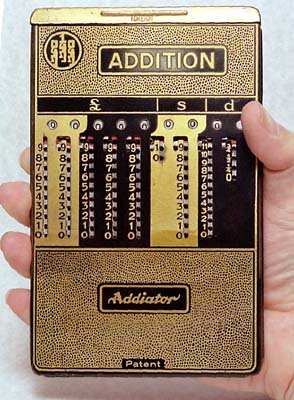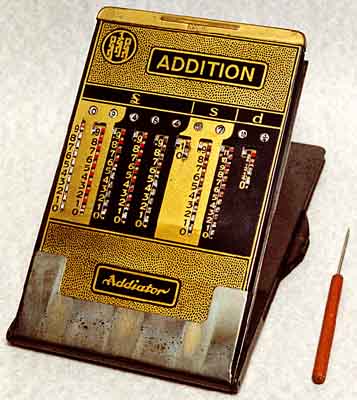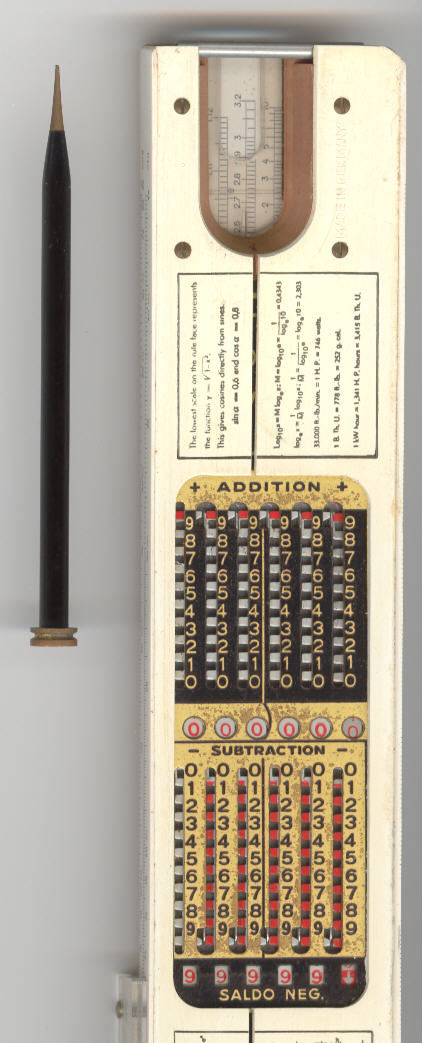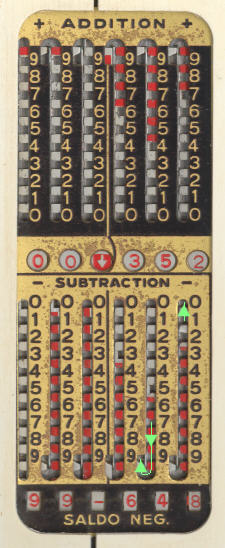Addiator
The number of slide ( also Griffeladdierer ) is a simple computing device for addition and subtraction of numbers. It consists of several in a flat housing displaceable parallel rods, each of which is used for a decimal point in the priority system.
For addition and subtraction, two different operating areas are needed. For some devices, these are with each other or the rods can be moved in both directions. In other devices depending on a region located on the front and on the back. Rods and casing are then shorter than unilaterally devices to be used.
Most devices are made of metal, simple versions made of cardboard. A special feature is the combination of a slide rule and a number cruncher.
The number crunchers there were already in the 16th century. In 1847 he was of the German Hermann Kummer, who invented a semi-automatic numeric transfer completes. Commonly known and used was the number crunchers, as the Frenchman Louis Troncet 1889 had brought a version under the name Arithmographe on the market. Number crunchers were built until they were replaced in the 1980s by the calculator. One of the most popular brands was the Addiator made in Germany, which became a synonym for number crunchers in the English language.
Function
The rods are provided in the middle of the length with a series of digits from 0 to 9. The one of these digits is visible as part of the calculation result through a small round window in the flat case. On both long sides of the rods are slotted. Nine out of the slots are left by long narrow windows in the housing externally accessible for servicing. The windows have a narrow hook-shaped extension at one end. You look like a walking stick ( run clear when Addiator, see below). By the hook portion of the currently underlying slot is accessible at the right-hand long side of the adjacent bar to the left, which is carried out on it of any necessary tens carry in the operation. The left -adjacent bar represents the nearest decimal number. It is the usual place value system: The units are quite right. To the left include the tens, hundreds, etc. of.
For calculating the bars are moved in the longitudinal direction with a stylus which is inserted into one of the available slots by the narrow window left a rod. The slot to be selected corresponds to be added to the / number value and is subtracted using the numeric scale found that is on the edge of each narrow window mounted on the housing. The tens are operated individually, the order is arbitrary.
Calculation example
The addition is performed ( see figure, bottom panel ) as follows:
The subtraction is done from the overhead, a mirror image of the bottom panel executed by moving the same rods. The procedures are analogous to those for addition, wherein the directions of movement are also a mirror image. With the most number sliders no arithmetic with a negative result is possible. Can be subtracted only if previously a larger or the same size value has been added. Special designs for potentially negative balance have for an extra result window. Also on their slides per additional, complementary to the previous set of numbers.
Number crunchers, each with a control panel on the front and on the back are reversed between the two sides over head ( rotation about a transverse axis ) ( A - Rod remains on the right). Thus, the directions of movement and also the views of the two panels are the same.
Model selection
Wizard: number cruncher with a control panel on the same side ( two parallel operating scales)
Addiator with panels on two sides
Addiator with panels on the same page
Logo of the brand Addiator










